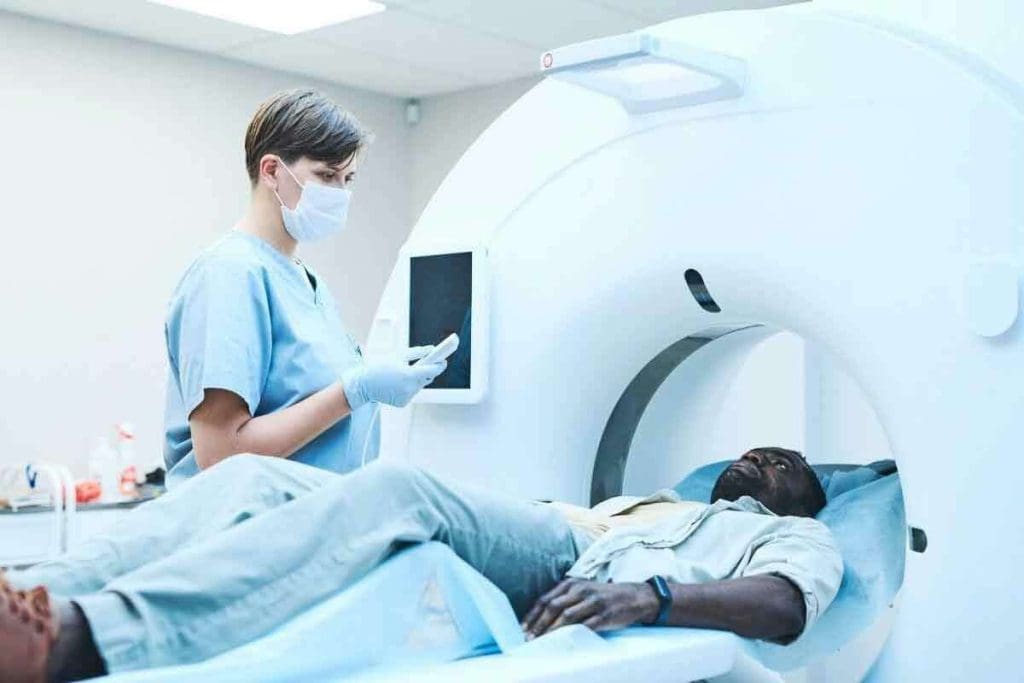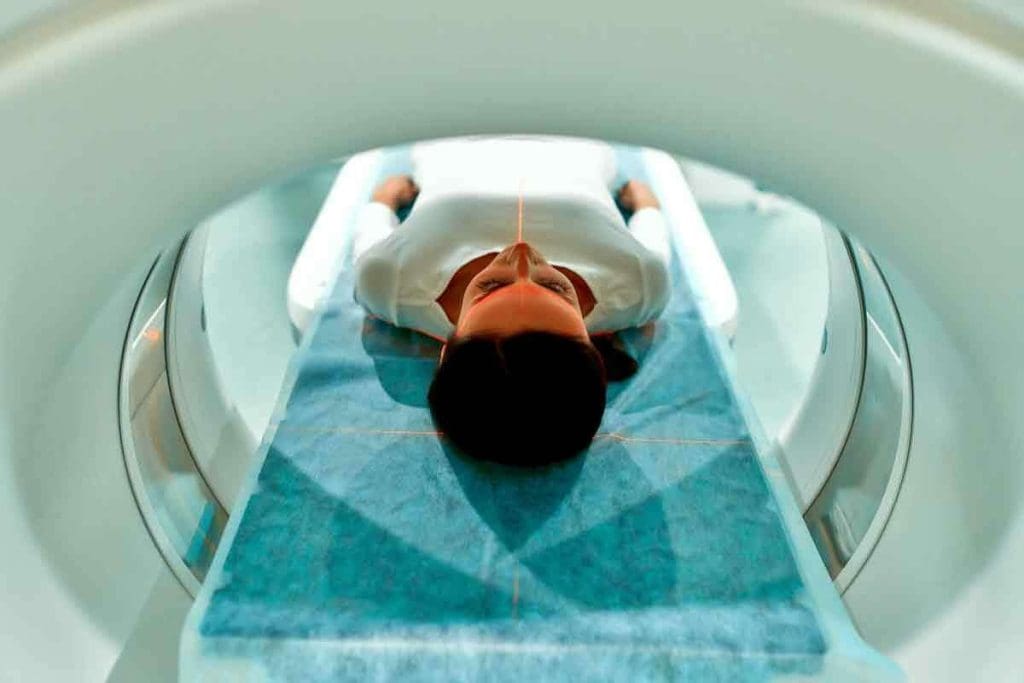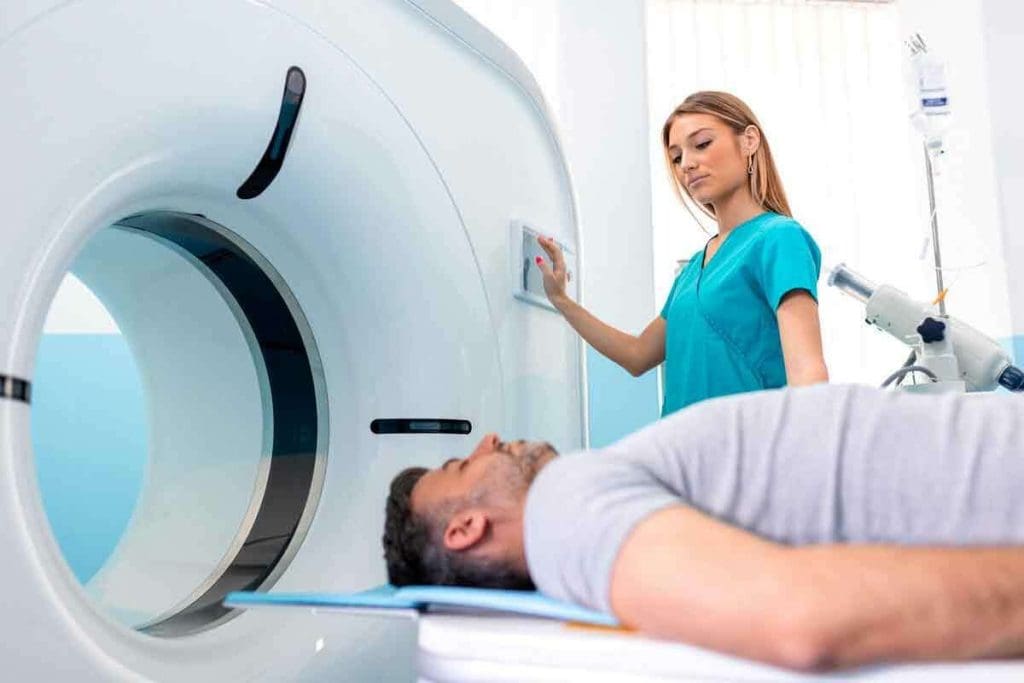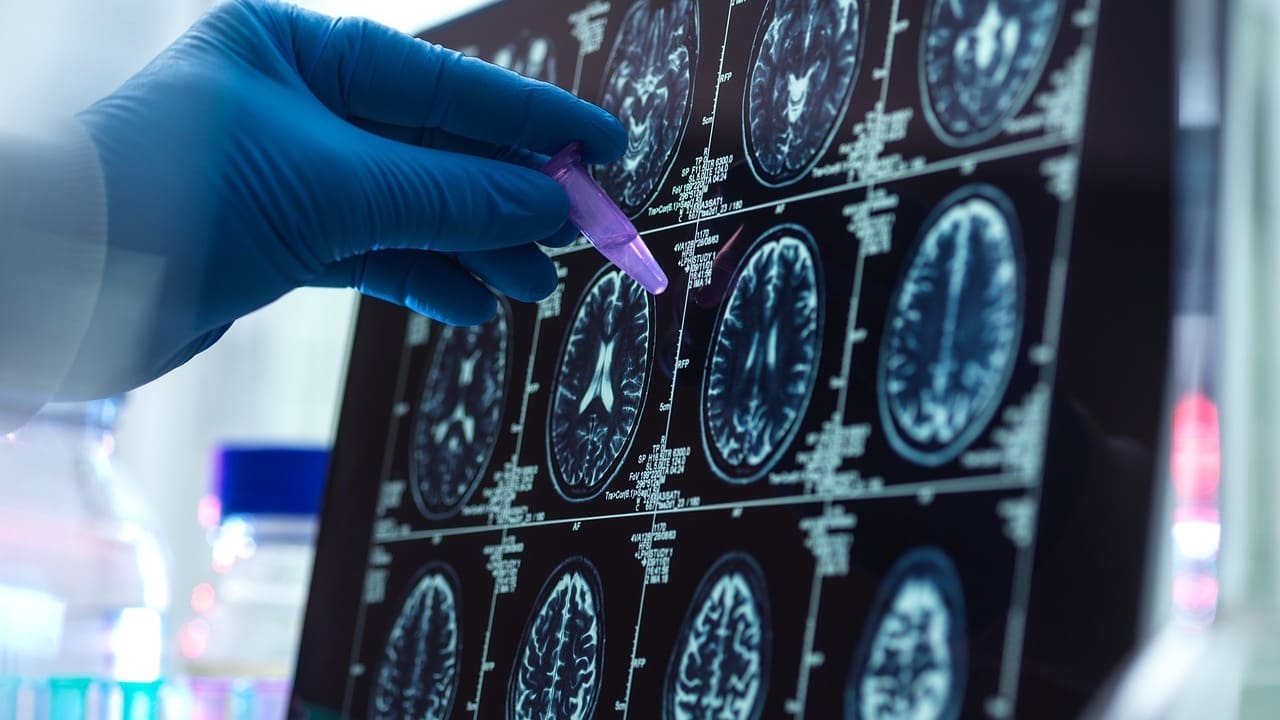Last Updated on November 27, 2025 by Bilal Hasdemir

When you get a cancer diagnosis, picking the right imaging test is key. At LIV Hospital, we focus on top-notch patient care and follow global standards. We explain the difference between MRI and PET scan: MRI provides detailed images of soft tissues and anatomy, while PET scans show metabolic activity and how tissues function. This difference between MRI and PET scan helps doctors get a full picture for accurate diagnosis and treatment planning.
A PET scan checks how active your cells are with a special tracer. It can spot cancer changes early. In contrast, an MRI uses strong magnets and radio waves to show soft tissues clearly. It’s great for seeing the body’s structure.
Knowing what each scan does is important for fighting cancer. We’ll look at how these tools work together in finding and treating cancer.
Key Takeaways
- PET scans assess metabolic activity to identify cancerous changes.
- MRI provides high-resolution images of soft tissues for anatomical visualization.
- Both imaging techniques are vital for accurate cancer diagnosis and treatment planning.
- Understanding the differences between PET and MRI scans is essential for effective cancer management.
- LIV Hospital is dedicated to providing advanced patient care and following international standards.
The Critical Role of Medical Imaging in Cancer Care

Medical imaging is key in cancer care. It gives vital info for diagnosis and treatment plans. We use imaging to guide diagnosis, treatment, and monitoring, improving patient results.
How Imaging Technologies Guide Cancer Diagnosis and Treatment
Technologies like PET and MRI scans are vital in cancer care. PET scans spot changes at the cellular level, helping with staging and spread evaluation. MRI scans show tumor details, important for soft tissue and brain exams.
A study on the National Center for Biotechnology Information shows these scans are key for accurate diagnosis and planning.
Using PET and MRI together gives a full view of tumors. This helps doctors create better treatment plans for each patient.
The Evolution of Cancer Detection Technologies
Cancer detection tech has grown a lot, with PET and MRI leading the way. New imaging gives clearer pictures and more info, helping find cancer early and diagnose it accurately.
The table below shows key differences between PET and MRI scans in cancer detection:
| Imaging Modality | Primary Use in Cancer Care | Key Benefits |
| PET Scan | Detecting metabolic changes in cancer cells | Early detection of cancer spread, monitoring treatment response |
| MRI | Visualizing soft tissue and structural details | Detailed tumor boundary visualization, assessing tumor extent |
As tech keeps improving, we’ll see even better tools for diagnosing cancer. This will lead to better patient outcomes.
Understanding MRI Technology

MRI technology is key in cancer care. It gives detailed images for diagnosis and treatment planning. MRI scans show the body’s inside, helping understand cancer and plan treatments.
How Magnetic Resonance Imaging Works
MRI scans use magnets and radio waves for detailed images. They align hydrogen atoms with a strong magnetic field. Then, radio waves disturb these atoms, causing them to send signals for the images.
The MRI machine creates a strong magnetic field. This field aligns the atoms. Radio waves disturb them, and the signals are captured to make images.
MRI Equipment and Procedure for Cancer Patients
Cancer patients often get MRI scans in a closed or open MRI machine. The procedure involves lying on a table that slides into the machine. The imaging happens inside.
The detailed images produced by MRI scans are vital for cancer diagnosis. They help doctors see tumor size, location, and extent. This info is key for cancer staging and treatment planning.
MRI technology is non-invasive and effective for soft tissue imaging and guiding cancer treatment. Its ability to provide detailed images makes it essential in oncology.
Understanding PET Scan Technology
Positron Emission Tomography (PET) scans give us a peek into how our bodies work. They help find cancer early. Unlike other scans, PET scans look at how cells work, not just their shape.
The Science Behind Positron Emission Tomography
PET scans use a special dye that lights up when it finds active cells. This dye is injected into the body. The scanner picks up the light, showing us where the body is working hard.
The dye is made from Fluorodeoxyglucose (FDG), a sugar that cells love. Cancer cells, which work fast, grab more of this sugar. This makes them show up bright on the scan.
How Radioactive Tracers Identify Cancer Cells
PET scans find cancer by looking at how cells use sugar. Cancer cells use more sugar than normal cells. This helps doctors spot cancer and see how it’s spreading.
“PET scans are great for finding cancer because they see how cells work, even before they look different on other scans.”
Here’s how PET scans compare to MRI for finding cancer:
| Characteristics | PET Scan | MRI |
| Primary Use | Metabolic activity assessment | Structural imaging |
| Cancer Detection Basis | Glucose metabolism | Anatomical changes |
| Sensitivity to Early Cancer | High | Variable |
Knowing how PET scans work helps doctors take better care of patients. They can spot cancer early and track how it’s doing.
The Fundamental Difference Between MRI and PET Scan
MRI and PET scans are key in fighting cancer. They help doctors plan treatments and improve patient care. Each scan has its own role and benefits.
Anatomical vs. Metabolic Imaging
MRI scans show detailed images of soft tissues. They help doctors see where tumors are and how big they are. PET scans, on the other hand, look at how cells work. They spot cancer cells because they use more energy than normal cells.
PET scans check how cells function, while MRI scans show tumor size. Together, they give a full picture of cancer.
Resolution, Sensitivity, and Specificity Comparisons
MRI scans have high detail for body structures. They’re great for planning surgeries and seeing tumor size. PET scans don’t show as much detail but are good at finding cancer in other parts of the body.
| Imaging Modality | Resolution | Sensitivity | Specificity |
| MRI | High | High for anatomical detail | High for structural abnormalities |
| PET | Lower than MRI | High for metabolic activity | High for detecting cancerous tissues |
Knowing the differences between MRI and PET scans is important. It helps doctors choose the best scan for each patient. This way, treatments can be more effective and tailored to each person’s needs.
PET Scan vs MRI Scan: Cancer Detection Capabilities
Choosing between PET and MRI scans for cancer detection depends on their strengths. Both are key in fighting cancer, but they have different roles in diagnosis.
Detecting Metabolic Changes with PET Scans
PET scans are great at spotting metabolic changes in cancer cells. They use radioactive tracers to find high activity areas, which is typical of cancer. This helps doctors find cancer early, even before it shows structural changes.
Early detection is key because it lets doctors start treatment sooner. This can lead to better outcomes. PET scans also show how well cancer is responding to treatment by tracking metabolic changes.
Soft Tissue and Structural Visualization with MRI
MRI scans are top-notch for detailed soft tissue and structural images. This makes MRI great for seeing tumor size and location, and how far cancer has spread.
MRI images are very clear, helping doctors plan surgeries or radiation therapy better. MRI is also good for tracking certain cancers, like brain tumors or musculoskeletal cancers, where detailed anatomy is important.
To sum up, PET scans find metabolic changes in cancer, while MRI scans give detailed anatomy. Together, they offer a full view of cancer, helping in diagnosis, treatment planning, and monitoring.
Clinical Applications in Oncology
MRI and PET scans have changed how we diagnose and treat cancer. They help us make accurate diagnoses and plan effective treatments.
Cancer Types Best Visualized by MRI
MRI is great for seeing soft tissue tumors. It’s key for diagnosing some cancers. For example, soft tissue sarcomas are clearer on MRI. It also helps with brain and spinal cord tumors because it shows details well.
- Brain tumors, such as gliomas and meningiomas
- Spinal cord tumors, including astrocytomas and ependymomas
- Soft tissue sarcomas, like liposarcomas and leiomyosarcomas
MRI also tracks how tumors react to treatment by showing tissue changes.
Cancer Conditions Where PET Scans Are Preferred
PET scans are best for finding and staging cancers with high activity. Lymphomas and certain lung cancers are better seen with PET scans. They spot metabolic changes early.
- Lymphomas, such as Hodgkin’s lymphoma and non-Hodgkin lymphoma
- Lung cancer, for seeing disease spread
- Melanoma, for finding metastasis
In summary, MRI and PET scans are vital in cancer care. Each has unique benefits. Knowing these helps doctors make better treatment plans.
Patient Considerations: Safety, Comfort, and Accessibility
It’s important to know the differences between MRI and PET scans for patient safety and comfort. When picking between these, we consider radiation, comfort, and how easy it is to get the scan.
Radiation Exposure in PET vs. Radiation-Free MRI
PET scans use a tiny bit of radioactive tracer, which might worry pregnant women or those needing many scans. MRI scans, on the other hand, don’t use radiation, making them safer for some patients.
PET Scan Radiation Exposure: The dose from a PET scan can change based on the tracer and the patient’s health. For example, a F-FDG PET scan might give about 7-10 mSv. MRI, not using ionizing radiation, has no risk of radiation.
| Imaging Modality | Radiation Exposure | Suitability for Pregnant Women | Suitability for Repeated Scans |
| PET Scan | Yes | No | Limited |
| MRI | No | Yes | High |
Procedure Experience and Contraindications
Getting an MRI or PET scan can be different for everyone. MRI scans need patients to stay very quiet in a tight space, which can be hard for those with claustrophobia or metal implants. PET scans are generally more comfortable but involve a radioactive tracer and might not be right for everyone, like those with diabetes.
Patient Comfort and Accessibility: MRI machines are getting more open, making them more comfortable. But, people with metal implants or pacemakers might not be able to have an MRI because of the strong magnetic field. PET scans are more widely available but need careful preparation, like fasting and managing blood sugar.
Healthcare providers can help patients choose the best imaging modality based on their needs and health. This ensures safety and accurate diagnosis.
The Power of Combined PET-MRI in Cancer Management
We are seeing big steps forward in cancer diagnosis with PET and MRI together. PET-MRI scans mix the best of positron emission tomography and magnetic resonance imaging. This makes diagnosing cancer more accurate.
By combining PET’s metabolic info with MRI’s detailed images, doctors get a clearer picture of tumors. This helps in planning better treatments and improving patient care.
Benefits of Integrated Metabolic and Anatomical Imaging
PET-MRI scans bring many benefits to cancer care. They give a precise look at tumor size and activity. This is key for staging and tracking how well treatments work.
- Enhanced Diagnostic Accuracy: PET-MRI combines metabolic and anatomical info for better tumor detection and characterization.
- Better Treatment Planning: The detailed insights from PET-MRI help doctors create more effective treatment plans.
- Reduced Radiation Exposure: PET-MRI is safer than PET-CT because it uses less radiation, making it better for long-term follow-ups.
A study showed PET-MRI is as good as or better than PET-CT for cancer patients. It also cuts down on radiation. Learn more about PET-MRI scans.
When Doctors Recommend Combined or Sequential Scans
Doctors might suggest PET-MRI scans or doing PET and MRI separately but together for diagnosis in different situations.
| Clinical Scenario | Benefits of PET-MRI |
| Tumor Staging | Accurate assessment of tumor extent and metabolic activity |
| Treatment Monitoring | Early detection of treatment response or resistance |
| Recurrence Detection | Identification of recurrent disease with high sensitivity and specificity |
PET-MRI is beneficial at every stage of cancer care, from diagnosis to follow-up.
In conclusion, combining PET and MRI is changing cancer care. PET-MRI scans give both metabolic and anatomical info. This improves diagnosis and treatment outcomes. As this tech evolves, we’ll see more ways it helps in fighting cancer.
Conclusion: Making Informed Decisions About Cancer Imaging
Knowing the difference between MRI and PET scans is key for smart choices in cancer care. We’ve looked at how these tools help in diagnosing and planning treatments.
MRI scans show detailed body structures, while PET scans highlight how cells work. Doctors pick the right scan based on the patient’s cancer type and stage.
Imaging like MRI and PET scans is essential in fighting cancer. Knowing their strengths helps patients and doctors make better choices for treatment.
As we move forward in cancer treatment, imaging will keep being a big part. Using MRI and PET scans well can lead to better care and outcomes for patients.
FAQ
What is the main difference between a PET scan and an MRI scan?
MRI scans show detailed images of soft tissues and body structures. PET scans, on the other hand, look at how cells work. They help find cancer by seeing metabolic changes.
Is a PET scan better than an MRI for cancer detection?
It depends on the cancer type and what you need to know. PET scans are great for spotting metabolic changes in cancer. MRI is better for soft tissue and structural details.
What is the difference between a PET scan and an MRI scan in terms of radiation exposure?
PET scans use a small amount of radiation from tracers. MRI scans don’t use radiation, making them safer for some patients.
Can PET and MRI scans be used together for cancer diagnosis?
Yes, PET-MRI scans combine metabolic and anatomical info. This improves diagnosis and helps plan treatments.
How do PET scans detect cancer cells?
PET scans use tracers that cancer cells absorb more than normal cells. These tracers show cancer activity on the scan.
What are the benefits of using MRI in cancer patients?
MRI shows soft tissue details. It helps see how far cancer has spread, check treatment effects, and plan surgery.
Are there any contraindications for MRI or PET scans?
Yes, metal implants, claustrophobia, or kidney issues might prevent MRI or PET scans. Talk to your doctor about your health before the scan.
How do doctors decide between MRI and PET scans for cancer patients?
Doctors choose based on cancer type, stage, and needed info. They might suggest one or both scans for each patient.
What is the difference between PET scan and MRI scan resolution?
MRI scans have higher resolution for detailed anatomy. PET scans offer metabolic activity info, but not as detailed.
Can PET scans detect cancer at an early stage?
Yes, PET scans can spot metabolic changes early. This is helpful when anatomical changes are not yet seen.
How do PET-MRI scans enhance cancer management?
PET-MRI scans combine metabolic and anatomical imaging. This gives a full view of cancer, improving diagnosis and treatment planning.
References
- National Cancer Institute. (2023). Positron emission tomography (PET) scans. https://www.cancer.gov/about-cancer/diagnosis-staging/diagnosis/pet-scan-fact-sheet






